Attached files
| file | filename |
|---|---|
| 8-K - FORM 8-K - Novelis Inc. | g21029e8vk.htm |
| EX-99.1 - EX-99.1 - Novelis Inc. | g21029exv99w1.htm |
Exhibit 99.2
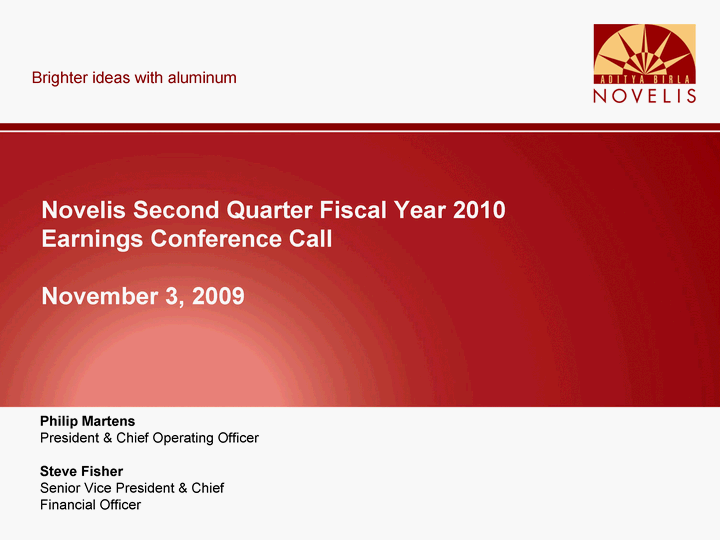
| Brighter ideas with aluminum Novelis Second Quarter Fiscal Year 2010 Earnings Conference Call November 3, 2009 Philip Martens President & Chief Operating Officer Steve Fisher Senior Vice President & Chief Financial Officer |
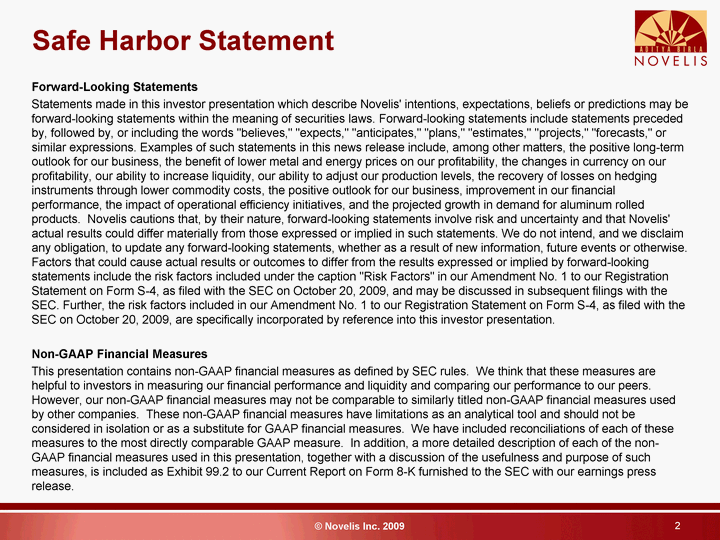
| Safe Harbor Statement 2 Forward-Looking Statements Statements made in this investor presentation which describe Novelis' intentions, expectations, beliefs or predictions may be forward-looking statements within the meaning of securities laws. Forward-looking statements include statements preceded by, followed by, or including the words "believes," "expects," "anticipates," "plans," "estimates," "projects," "forecasts," or similar expressions. Examples of such statements in this news release include, among other matters, the positive long-term outlook for our business, the benefit of lower metal and energy prices on our profitability, the changes in currency on our profitability, our ability to increase liquidity, our ability to adjust our production levels, the recovery of losses on hedging instruments through lower commodity costs, the positive outlook for our business, improvement in our financial performance, the impact of operational efficiency initiatives, and the projected growth in demand for aluminum rolled products. Novelis cautions that, by their nature, forward-looking statements involve risk and uncertainty and that Novelis' actual results could differ materially from those expressed or implied in such statements. We do not intend, and we disclaim any obligation, to update any forward-looking statements, whether as a result of new information, future events or otherwise. Factors that could cause actual results or outcomes to differ from the results expressed or implied by forward-looking statements include the risk factors included under the caption "Risk Factors" in our Amendment No. 1 to our Registration Statement on Form S-4, as filed with the SEC on October 20, 2009, and may be discussed in subsequent filings with the SEC. Further, the risk factors included in our Amendment No. 1 to our Registration Statement on Form S-4, as filed with the SEC on October 20, 2009, are specifically incorporated by reference into this investor presentation. Non-GAAP Financial Measures This presentation contains non-GAAP financial measures as defined by SEC rules. We think that these measures are helpful to investors in measuring our financial performance and liquidity and comparing our performance to our peers. However, our non-GAAP financial measures may not be comparable to similarly titled non-GAAP financial measures used by other companies. These non-GAAP financial measures have limitations as an analytical tool and should not be considered in isolation or as a substitute for GAAP financial measures. We have included reconciliations of each of these measures to the most directly comparable GAAP measure. In addition, a more detailed description of each of the non- GAAP financial measures used in this presentation, together with a discussion of the usefulness and purpose of such measures, is included as Exhibit 99.2 to our Current Report on Form 8-K furnished to the SEC with our earnings press release. |
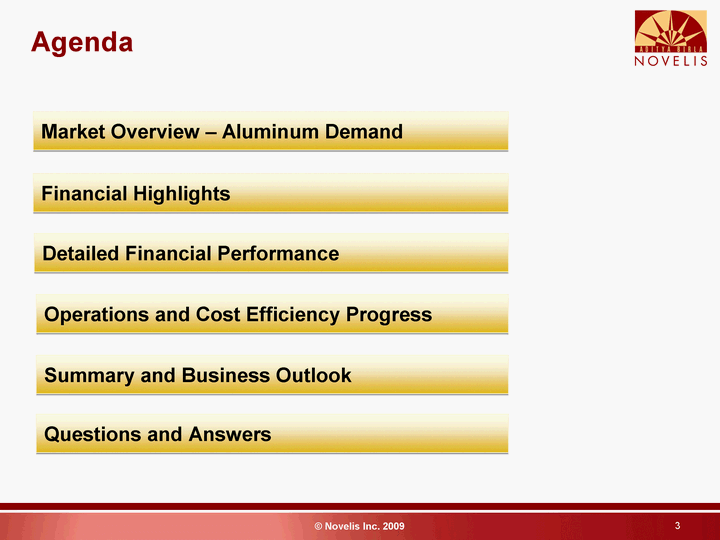
| 3 Agenda Market Overview - Aluminum Demand Financial Highlights Detailed Financial Performance Summary and Business Outlook Operations and Cost Efficiency Progress Questions and Answers |
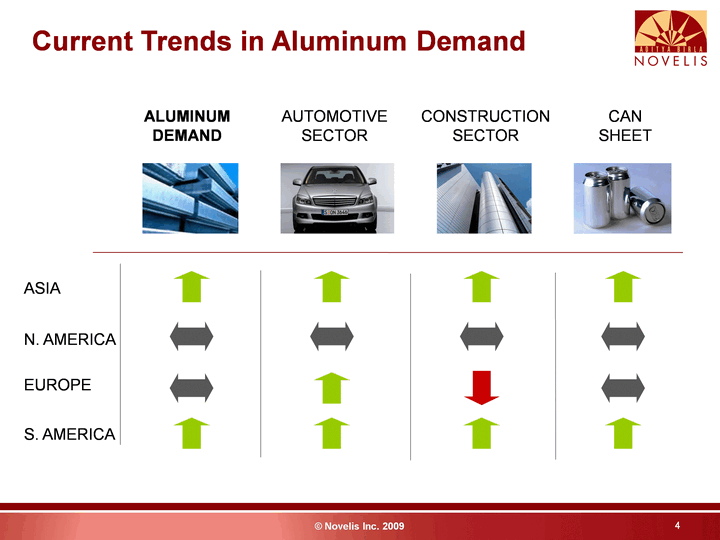
| 4 4 CONSTRUCTION SECTOR AUTOMOTIVE SECTOR CAN SHEET N. A. EUROPE S. A. ASIA ALUMINUM DEMAND Current Trends in Aluminum Demand |
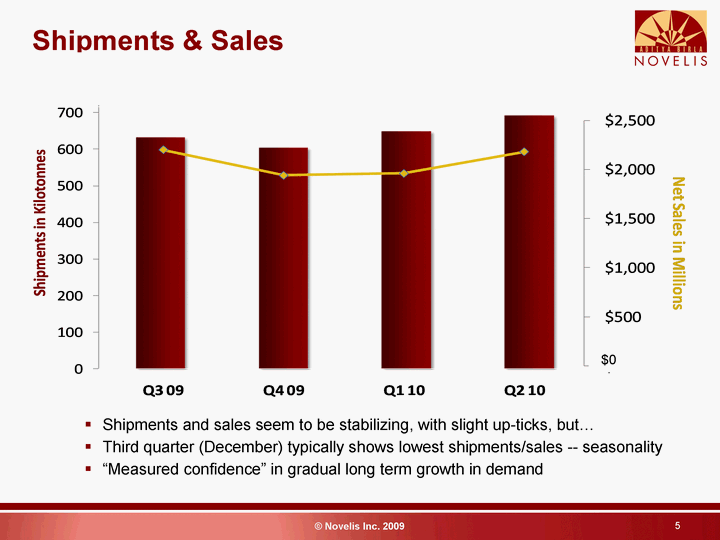
| Shipments & Sales $0 Shipments and sales seem to be stabilizing, with slight up-ticks, but... Third quarter (December) typically shows lowest shipments/sales -- seasonality "Measured confidence" in gradual long term growth in demand 5 |
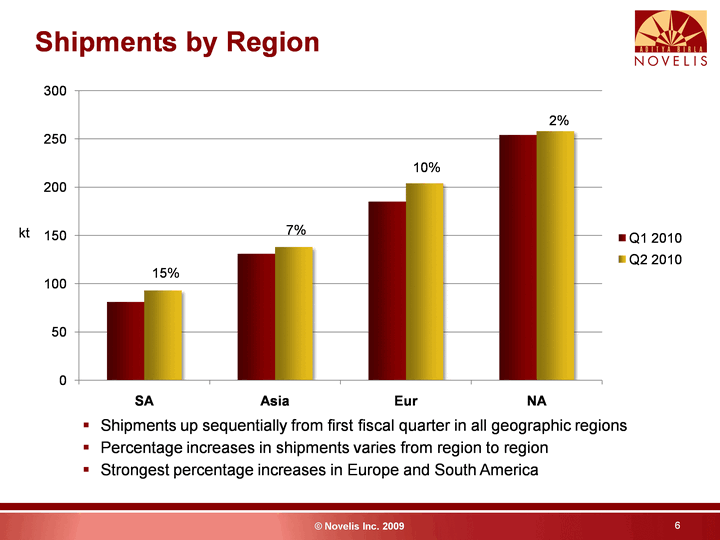
| 6 Shipments by Region Shipments up sequentially from first fiscal quarter in all geographic regions Percentage increases in shipments varies from region to region Strongest percentage increases in Asia and South America Strongest percentage increases in Asia and South America Strongest percentage increases in Asia and South America Strongest percentage increases in Asia and South America 15% 7% 10% 2% kt |

| 7 Quarterly Financial Performance Against stabilizing-to-slightly growing shipments and sales: Pre-tax income continues to grow over the past three quarters Net Income continues positive growth from loss in Q4 of 2009 fiscal year Adjusted EBITDA continues to improve as well |
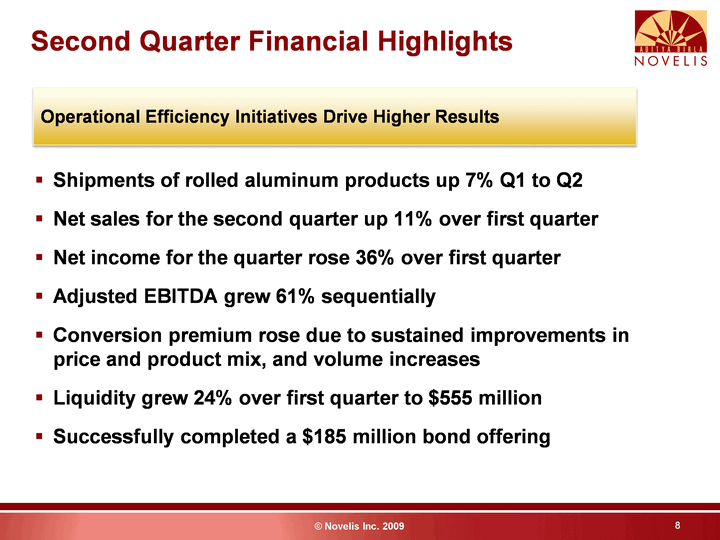
| 8 Second Quarter Financial Highlights Shipments of rolled aluminum products up 7% Q1 to Q2 Net sales for the second quarter up 11% over first quarter Net income for the quarter rose 36% over first quarter Adjusted EBITDA grew 61% sequentially Conversion premium rose in all four regions due to price and product mix improvements Liquidity grew 24% over first quarter to $555 million Successfully completed a $185 million bond offering Operational Efficiency Initiatives Drive Higher Results |
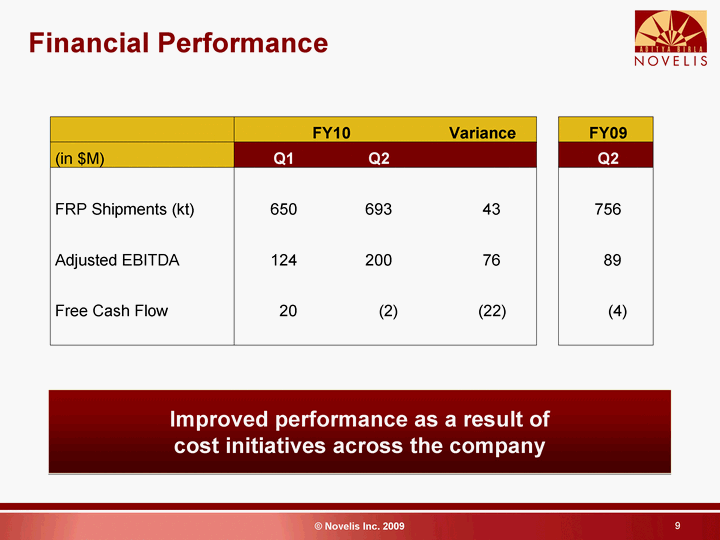
| 9 Financial Performance Improved performance as a result of cost initiatives across the company FY10 FY10 Variance FY09 (in $M) Q1 Q2 Q2 FRP Shipments (kt) 650 693 43 756 Adjusted EBITDA 124 200 76 89 Free Cash Flow 20 (2) (22) (4) |
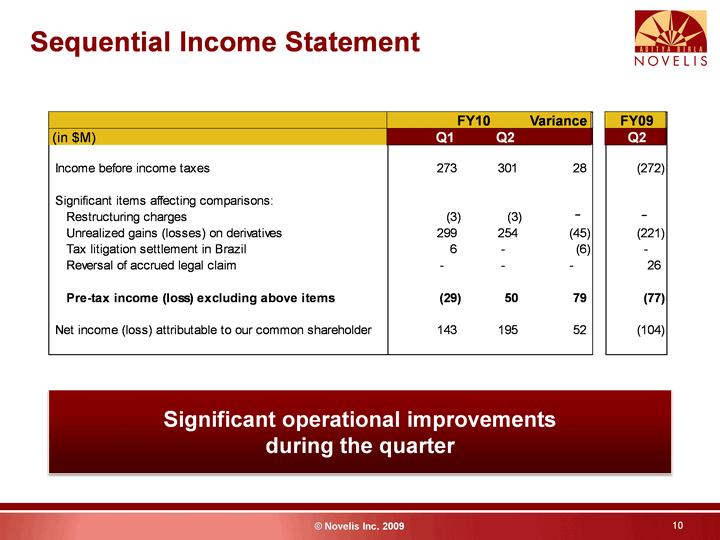
| 10 Sequential Income Statement Significant operational improvements during the quarter FY10 FY10 Variance FY09 (in $M) Q1 Q2 Q2 |
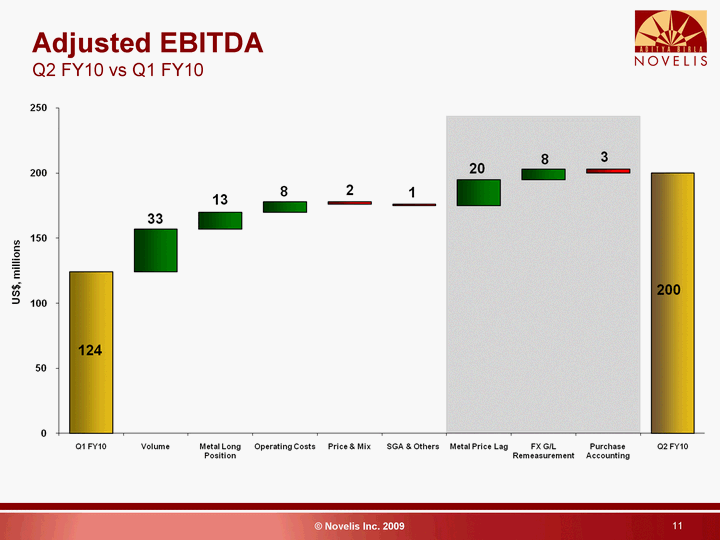
| 11 Adjusted EBITDA Q2 FY10 vs Q1 FY10 |
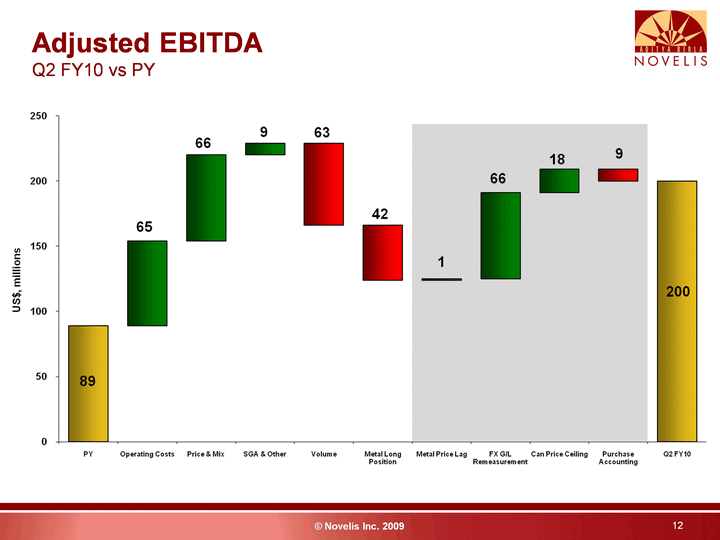
| 12 Adjusted EBITDA Q2 FY10 vs PY |
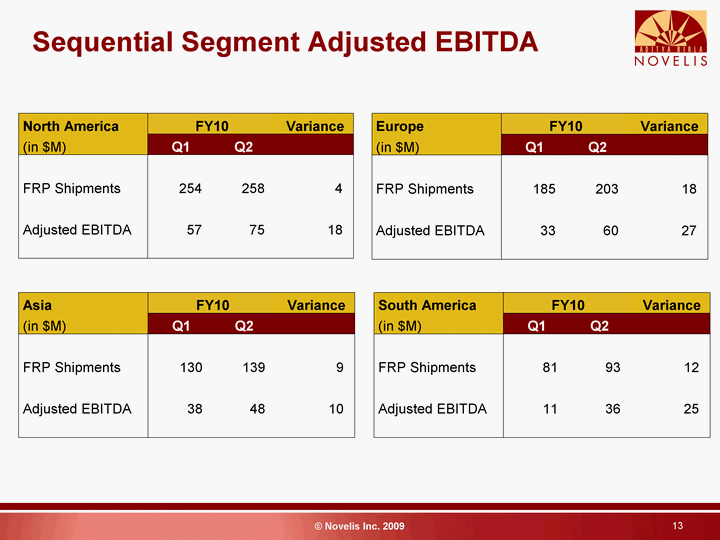
| 13 Sequential Segment Adjusted EBITDA North America FY10 FY10 Variance (in $M) Q1 Q2 FRP Shipments 254 258 4 Adjusted EBITDA 57 75 18 Europe FY10 FY10 Variance (in $M) Q1 Q2 FRP Shipments 185 203 18 Adjusted EBITDA 33 60 27 Asia FY10 FY10 Variance (in $M) Q1 Q2 FRP Shipments 130 139 9 Adjusted EBITDA 38 48 10 South America FY10 FY10 Variance (in $M) Q1 Q2 FRP Shipments 81 93 12 Adjusted EBITDA 11 36 25 |
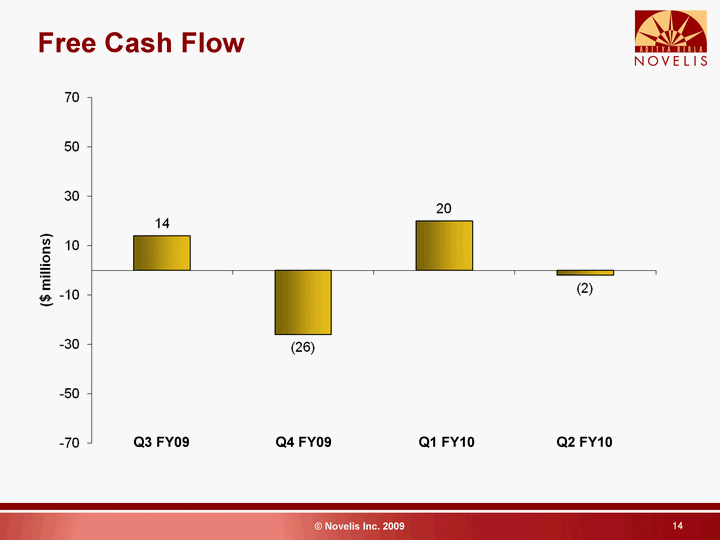
| 14 Free Cash Flow Q3 FY09 Q4 FY09 Q1 FY10 Q2 FY10 |
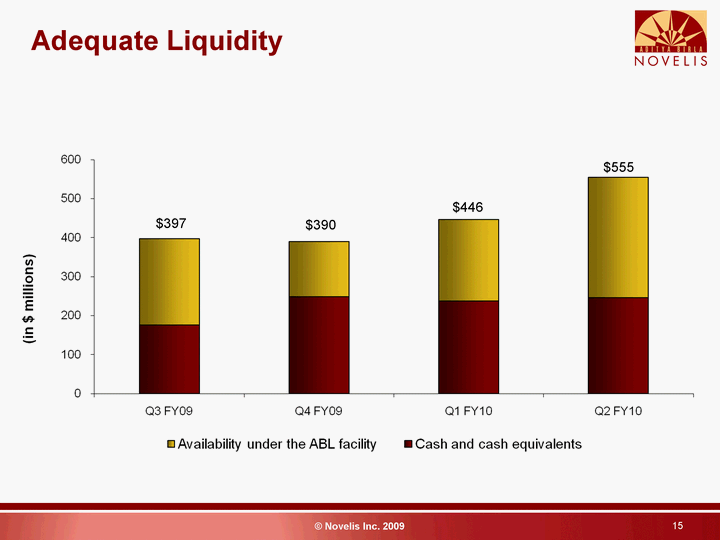
| 15 Adequate Liquidity $397 $390 $446 $555 |
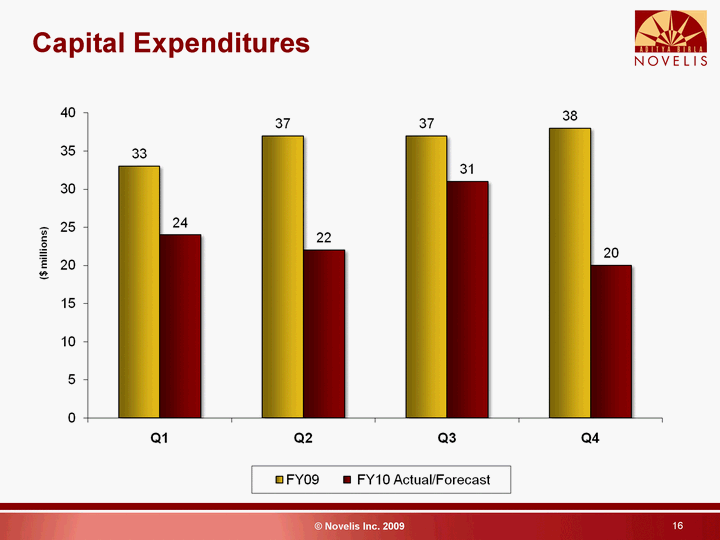
| 16 Capital Expenditures |
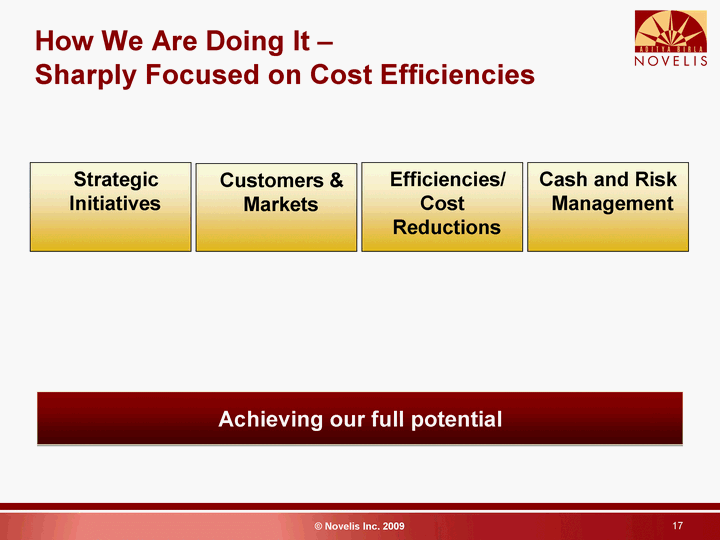
| 17 Strategic Initiatives How We Are Doing It - Sharply Focused on Cost Efficiencies Achieving our full potential Customers & Markets Efficiencies/ Cost Reductions Cash and Risk Management |
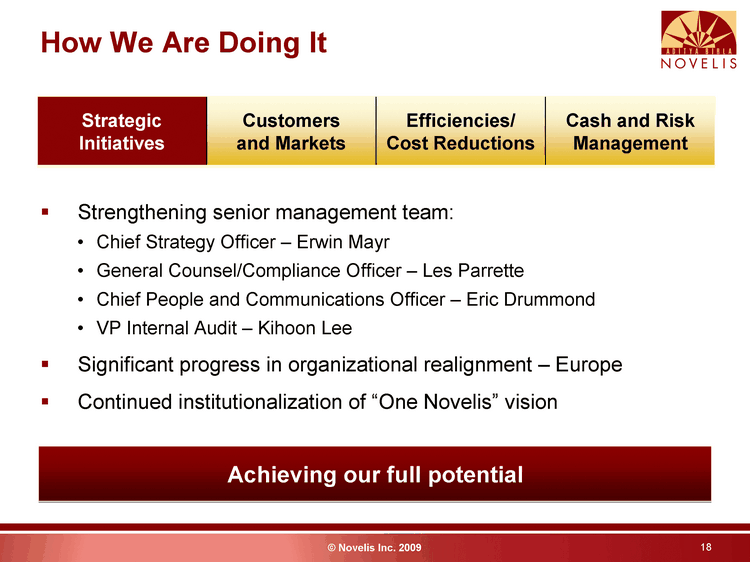
| 18 How We Are Doing It Achieving our full potential Strengthening senior management team Chief Strategy Officer - Erwin Mayr General Counsel/Compliance Officer - Les Parrette Chief People and Communications Officer - Eric Drummond Significant progress in organizational realignment - Europe Continued institutionalization of "One Novelis" vision Strategic Initiatives Customers and Markets Efficiencies/ Cost Reductions Cash and Risk Management |
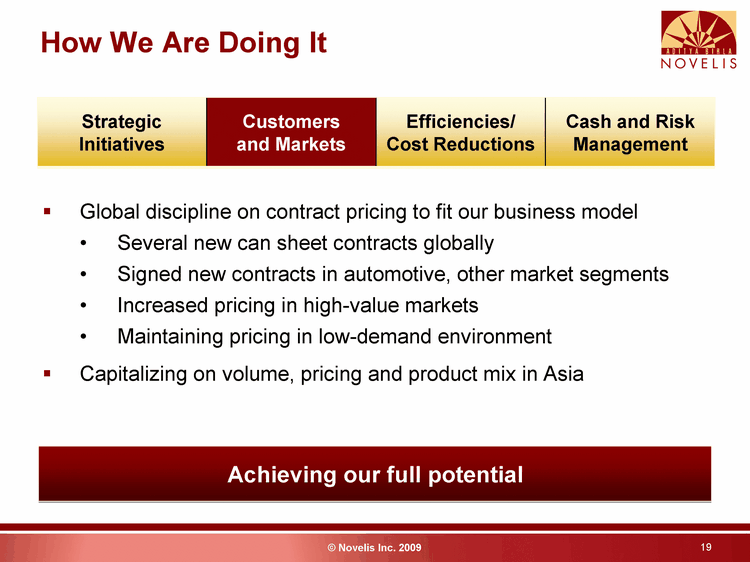
| 19 How We Are Doing It Achieving our full potential Global discipline on contract pricing to fit our business model Several new can sheet contracts globally Signed new contracts in automotive, other market segments Maintaining pricing in low-demand environment Increasing pricing in high-value markets Maximizing product mix opportunities Capitalizing on volume, pricing and product mix in Asia Strategic Initiatives Customers and Markets Efficiencies/ Cost Reductions Cash and Risk Management |
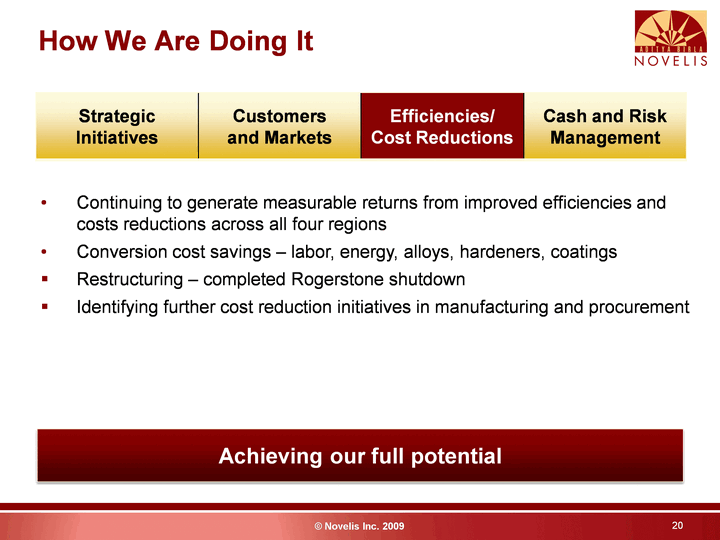
| 20 How We Are Doing It Achieving our full potential Continuing to generate measurable returns from improved efficiencies and costs reductions across all four regions Cost controls - standardizing procurement processes Conversion cost savings - labor, energy, alloys, hardeners, coatings Restructuring - completed Rogerstone shutdown Identifying further cost reduction initiatives in manufacturing and procurement Strategic Initiatives Customers and Markets Efficiencies/ Cost Reductions Cash and Risk Management |
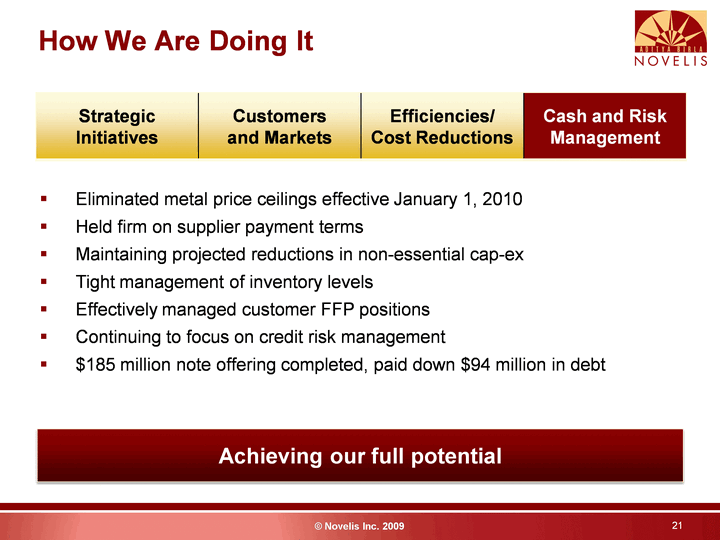
| 21 How We Are Doing It Achieving our full potential Eliminated metal price ceilings effective January 1, 2010 Held firm on supplier payment terms Maintaining projected reductions in non-essential cap-ex Managing inventory levels to match production levels Effectively managed customer FFP positions Continuing to focus on credit management for improved liquidity $185 million note offering completed, paid down $94 million in debt Strategic Initiatives Customers and Markets Efficiencies/ Cost Reductions Cash and Risk Management |
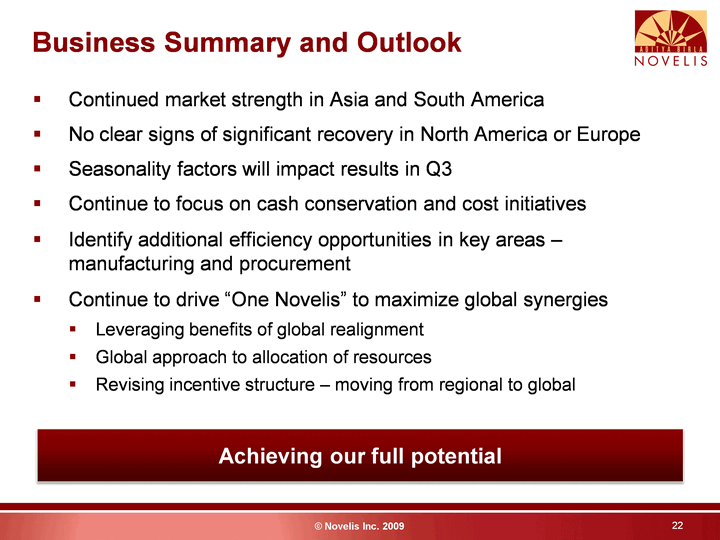
| 22 Business Summary and Outlook Asia and South America continue to be strong No clear signs of significant recovery in North America or Europe Seasonality factors will impact results in Q3 Continue to focus on cash conservation and cost initiatives Identify additional efficiency opportunities in key areas - manufacturing and procurement Continue to drive "One Novelis" to maximize global synergies Leveraging benefits of global realignment Global approach to allocation of resources Revising incentive structure - moving from regional to global Achieving our full potential |
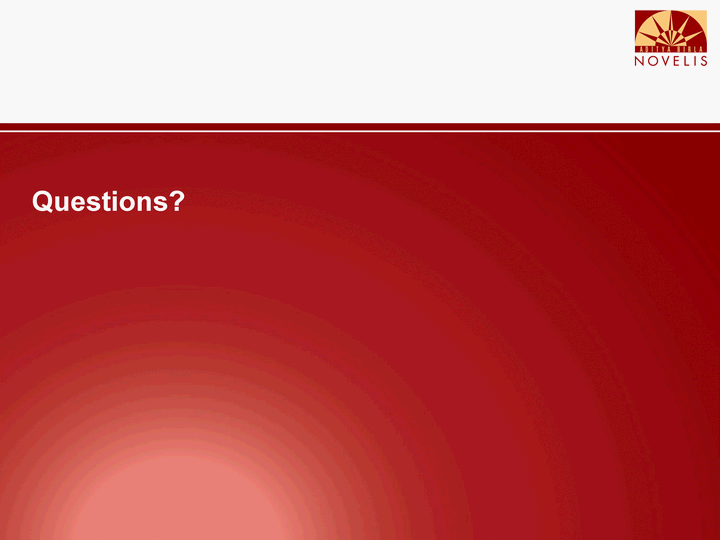
| 23 Questions? |
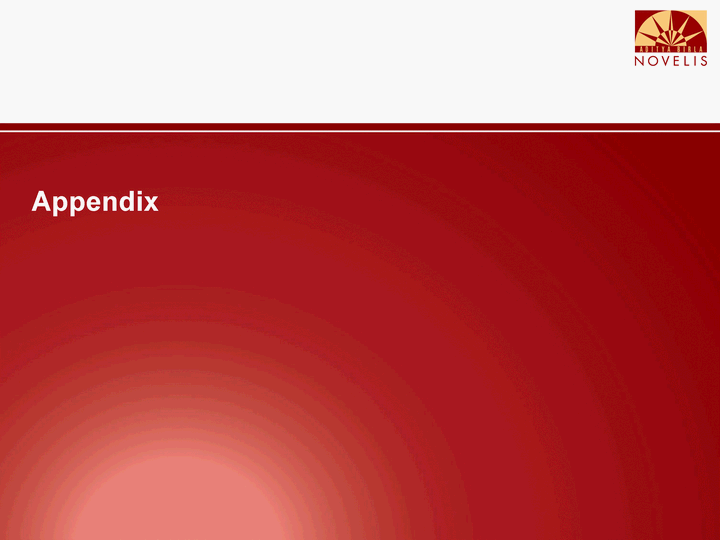
| 24 Appendix |
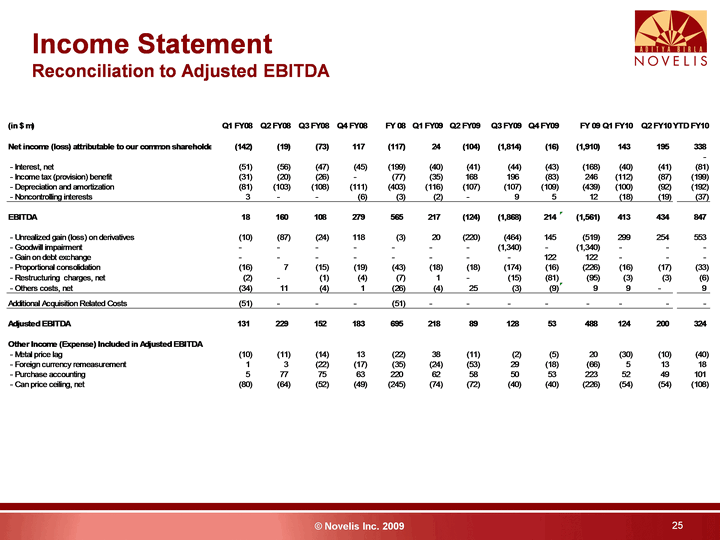
| 25 Income Statement Reconciliation to Adjusted EBITDA |
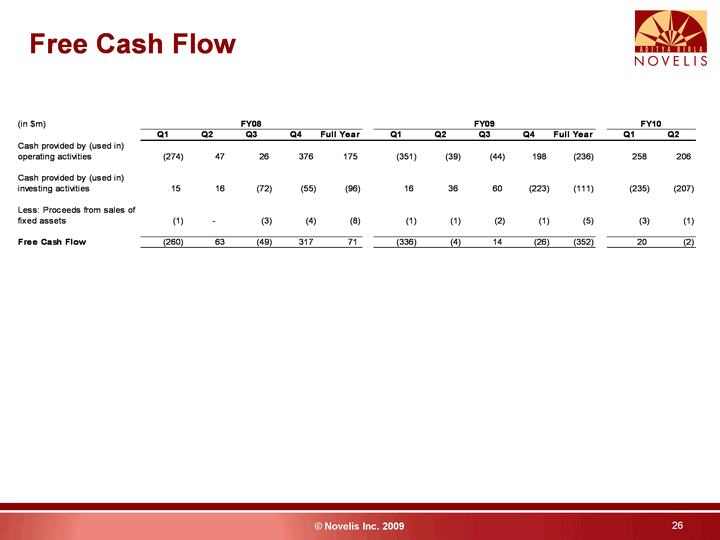
| 26 Free Cash Flow |
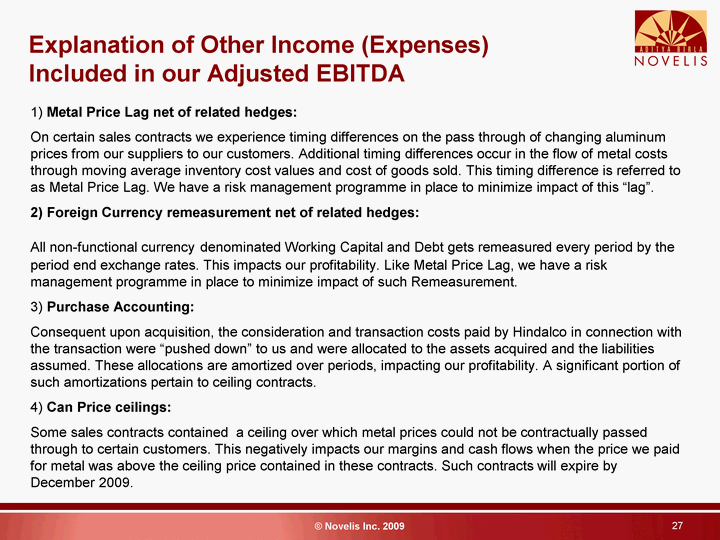
| 27 Explanation of Other Income (Expenses) Included in our Adjusted EBITDA 1) Metal Price Lag net of related hedges: On certain sales contracts we experience timing differences on the pass through of changing aluminum prices from our suppliers to our customers. Additional timing differences occur in the flow of metal costs through moving average inventory cost values and cost of goods sold. This timing difference is referred to as Metal Price Lag. We have a risk management programme in place to minimize impact of this "lag". 2) Foreign Currency remeasurement net of related hedges: All non-functional currency denominated Working Capital and Debt gets remeasured every period by the period end exchange rates. This impacts our profitability. Like Metal Price Lag, we have a risk management programme in place to minimize impact of such Remeasurement. 3) Purchase Accounting: Consequent upon acquisition, the consideration and transaction costs paid by Hindalco in connection with the transaction were "pushed down" to us and were allocated to the assets acquired and the liabilities assumed. These allocations are amortized over periods, impacting our profitability. A significant portion of such amortizations pertain to ceiling contracts. 4) Can Price ceilings: Some sales contracts contained a ceiling over which metal prices could not be contractually passed through to certain customers. This negatively impacts our margins and cash flows when the price we paid for metal was above the ceiling price contained in these contracts. Such contracts will expire by December 2009. |
